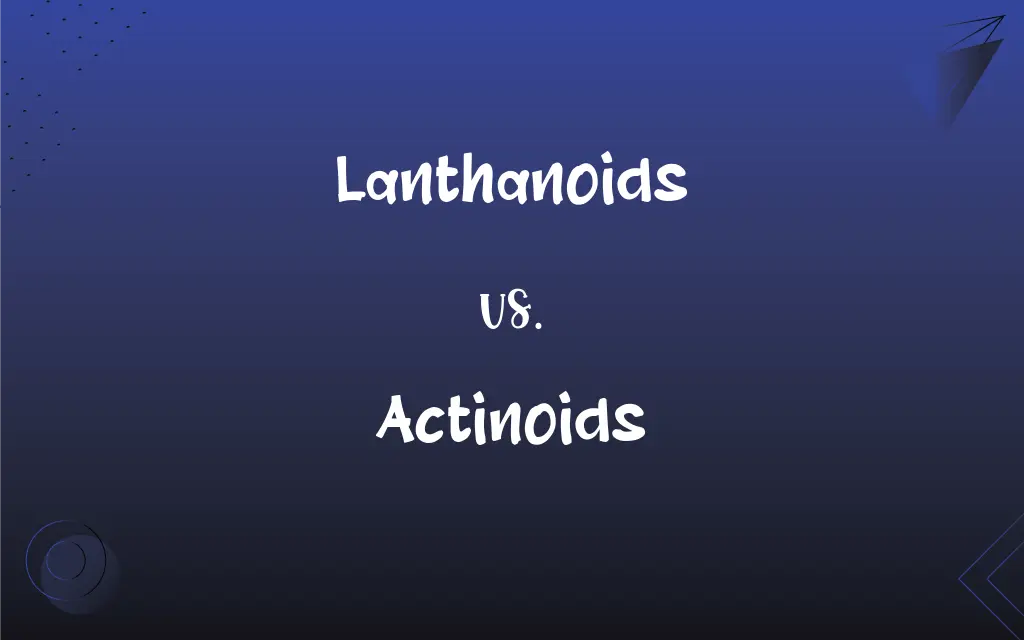Lanthanoids vs. Actinoids: What's the Difference?
Edited by Aimie Carlson || By Janet White || Published on November 5, 2024
Lanthanoids are elements with atomic numbers 57-71, part of the f-block, known for magnetic and phosphorescent properties. Actinoids, atomic numbers 89-103, also in the f-block, are radioactive and have significant nuclear applications.

Key Differences
Lanthanoids comprise elements from lanthanum to lutetium, occupying the 6th period of the periodic table. These elements are characterized by their filling of the 4f electron orbitals. Actinoids, spanning from actinium to lawrencium, are found in the 7th period, filling the 5f orbitals. Both sets are part of the inner transition metals, but their electron configurations lead to distinct chemical and physical properties.
In terms of physical properties, lanthanoids are known for their ability to produce strong magnetic fields and their use in phosphorescent materials. They are relatively abundant in the Earth's crust compared to actinoids, which are significantly less stable and more radioactive. This radioactivity in actinoids stems from their unstable nuclei, making them key components in nuclear reactors and weapons.
Chemically, lanthanoids exhibit a gradual decrease in ionic radii known as the lanthanide contraction, affecting their chemical behavior and reactivity. Actinoids, on the other hand, show a more complex chemistry due to their actinide contraction, influencing their oxidation states and compounds' stability. The chemistry of actinoids is further complicated by their radioactivity, leading to applications in fields such as nuclear medicine and energy.
Environmentally and technologically, lanthanoids play critical roles in renewable energy technologies, such as in wind turbines and hybrid vehicle batteries. Actinoids, with their nuclear properties, are pivotal in nuclear energy production and in medical isotopes for cancer treatment. Despite their usefulness, both groups pose environmental challenges, especially actinoids, due to their radioactive waste.
In terms of applications, lanthanoids are extensively used in electronics, optics, and materials science, thanks to their unique magnetic and luminescent properties. Actinoids, with their radioactive nature, find critical use in nuclear reactors and in radiopharmaceuticals, showcasing their importance in energy and medicine, despite the inherent risks and challenges in handling and disposal.
ADVERTISEMENT
Comparison Chart
Spelling Variation
"Lanthanoids" sometimes spelled as "lanthanides."
"Actinoids" also referred to as "actinides."
Prefix Origin
Derived from "lanthanum," the first element in the series.
Derived from "actinium," indicating the start of the series.
Suffix Usage
"-oid" implies similarity to lanthanum.
"-oid" implies similarity to actinium.
Element Group
Part of the f-block, specifically the 4f series.
Part of the f-block, specifically the 5f series.
Chemical Behavior
Less radioactive, more stable.
Highly radioactive, less stable.
ADVERTISEMENT
Lanthanoids and Actinoids Definitions
Lanthanoids
Essential for manufacturing high-strength magnets.
Neodymium, a lanthanoid, is a key component of powerful permanent magnets.
Actinoids
A series of radioactive elements from actinium to lawrencium.
Uranium, an actinoid, is a primary fuel for nuclear reactors.
Lanthanoids
A group of 15 metallic elements from lanthanum to lutetium in the periodic table.
Gadolinium, a lanthanoid, is used in MRI contrast agents.
Actinoids
Characterized by their significant nuclear properties.
Plutonium, an actinoid, is used in nuclear weapons and reactors.
Lanthanoids
Known for their magnetic and phosphorescent properties.
Europium, a lanthanoid, enhances the red color in TV screens.
Actinoids
Used in medicine for cancer treatment.
Americium, an actinoid, is employed in smoke detectors and industrial gauges.
Lanthanoids
Used in refining petroleum and manufacturing glass.
Cerium, a lanthanoid, is utilized in catalytic converters for automobiles.
Actinoids
Have a key role in nuclear energy and weaponry.
Thorium, an actinoid, is being explored as a safer nuclear reactor fuel.
Lanthanoids
Integral to modern energy-saving lighting solutions.
Terbium, a lanthanoid, is used in fluorescent lamps.
Actinoids
Present environmental and handling challenges due to radioactivity.
Neptunium, an actinoid, is a hazardous waste from nuclear reactors.
Lanthanoids
See lanthanide.
Actinoids
Plural of actinoid
Lanthanoids
Plural of lanthanoid
FAQs
What are common uses of lanthanoids?
Lanthanoids are used in magnets, electronics, lighting, and glass making.
How do lanthanoids differ from actinoids in terms of radioactivity?
Lanthanoids are less radioactive and more stable than actinoids, which are highly radioactive.
Do lanthanoids and actinoids share any chemical properties?
Both groups exhibit variable oxidation states and complex chemistry due to their f-orbital electron configurations.
How are lanthanoids extracted and refined?
Lanthanoids are extracted from minerals like monazite and bastnasite through various chemical processes.
Are lanthanoids toxic?
Some lanthanoids can be mildly toxic, but their environmental and health impacts are generally less severe than actinoids.
What are actinoids?
Actinoids are elements with atomic numbers 89-103, all radioactive with significant nuclear applications.
What are common uses of actinoids?
Actinoids are used in nuclear reactors, nuclear weapons, and some in medicine.
Why are actinoids more hazardous than lanthanoids?
Due to their high radioactivity, actinoids pose greater health and environmental risks.
What are lanthanoids?
Lanthanoids are elements with atomic numbers 57-71, known for magnetic and phosphorescent properties.
Can lanthanoids and actinoids be found in nature?
Lanthanoids are more abundant in nature, while most actinoids are synthetic or present in trace amounts.
What environmental concerns are associated with lanthanoids?
Mining and refining lanthanoids can lead to pollution and habitat destruction.
What role do lanthanoids play in renewable energy?
Lanthanoids are crucial in the production of high-efficiency magnets for wind turbines and batteries for electric vehicles.
How are actinoids handled safely?
Due to their radioactivity, actinoids require strict safety protocols, including shielding and remote handling.
Can lanthanoids and actinoids form compounds?
Yes, both can form a wide range of compounds, often exhibiting unique chemical behaviors due to their electron configurations.
Are there sustainable alternatives to using lanthanoids and actinoids?
Research is ongoing to find less harmful and more sustainable alternatives, especially in energy and electronics.
What role do actinoids play in nuclear energy?
Actinoids, especially uranium and thorium, are key fuels for nuclear reactors.
What environmental concerns are associated with actinoids?
The main concerns include radioactive waste management and the potential for nuclear accidents.
How are actinoids produced?
Most actinoids are produced synthetically in nuclear reactors or particle accelerators.
What is the lanthanide contraction?
The lanthanide contraction refers to the gradual decrease in ionic radii across the lanthanoid series, affecting their chemical properties.
What is the actinide contraction?
Similar to the lanthanide contraction, the actinide contraction involves a decrease in ionic radii across the actinoid series, influencing their chemistry.
About Author
Written by
Janet WhiteJanet White has been an esteemed writer and blogger for Difference Wiki. Holding a Master's degree in Science and Medical Journalism from the prestigious Boston University, she has consistently demonstrated her expertise and passion for her field. When she's not immersed in her work, Janet relishes her time exercising, delving into a good book, and cherishing moments with friends and family.
Edited by
Aimie CarlsonAimie Carlson, holding a master's degree in English literature, is a fervent English language enthusiast. She lends her writing talents to Difference Wiki, a prominent website that specializes in comparisons, offering readers insightful analyses that both captivate and inform.







































































